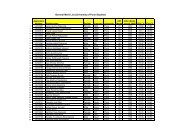Non-parametric estimation of a time varying GARCH model
Non-parametric estimation of a time varying GARCH model
Non-parametric estimation of a time varying GARCH model
You also want an ePaper? Increase the reach of your titles
YUMPU automatically turns print PDFs into web optimized ePapers that Google loves.
Then, the exact expressions for the estimators are given by<br />
ˆω(u0) = e ⊤ 1,3(d+1) (X⊤ 2 W2X2) −1 X ⊤ 2 W2Y2,<br />
ˆα(u0) = e ⊤ d+2,3(d+1) (X⊤ 2 W2X2) −1 X ⊤ 2 W2Y2 and<br />
ˆβ(u0) = e ⊤ 2d+3,3(d+1) (X⊤ 2 W2X2) −1 X ⊤ 2 W2Y2.<br />
The final estimates <strong>of</strong> σ 2 t in tv<strong>GARCH</strong> <strong>model</strong> can be obtained using these estimators.<br />
These estimators achieve the optimal rate <strong>of</strong> convergence when an optimal bandwidth is<br />
used (see Section 4).<br />
3.1 Bandwidth selection<br />
As will be discussed in the next section, the two step estimator is not very sensitive to the<br />
choice <strong>of</strong> initial bandwidth h1 as long as it is small enough, so that the bias in the first<br />
step is asymptotically negligible. Therefore, one can simply apply the standard univariate<br />
bandwidth selection procedures to select the smoothing parameter for Step 2. The initial<br />
smoothing parameter can be chosen according to the second step bandwidth. For the<br />
practical implementation, we select the optimal bandwidth (h2) using the cross validation<br />
method based on the best linear predictor <strong>of</strong> ǫ2 t given the past (see Hart (1994)), which<br />
is, ω � �<br />
t + α n<br />
� �<br />
t ǫ n<br />
2 t−1 + β � �<br />
t σ n<br />
2 t−1. That is, such a bandwidth (h2) is chosen for which,<br />
CV (h2) = 1<br />
n−1<br />
n�<br />
t=2<br />
�<br />
ǫ2 t − ˆω −t (ut) − ˆα −t (ut)ǫ2 t−1 − ˆ β−t (ut)σ2 �2 t−1<br />
is minimum, where ˆω −t (ut), ˆα −t (ut) and ˆ β−t (ut) denote the local polynomial estimators<br />
<strong>of</strong> ω � �<br />
t ,α n<br />
� �<br />
t and β n<br />
� �<br />
t obtained by leaving the t n<br />
th observation. A pilot bandwidth is<br />
chosen initially to get the initial estimate <strong>of</strong> σ 2 t−1 using the full data. Using the similar<br />
arguments as in Hart (1994), asymptotically it can be shown that such a bandwidth is<br />
a minimizer <strong>of</strong> the mean squared prediction error <strong>of</strong> ǫ 2 t. The pilot bandwidth should be<br />
small enough to be <strong>of</strong> o(h2) and at the same <strong>time</strong>, should satisfy nh1 → ∞. In case, if<br />
h2 comes out be such that the pilot bandwidth is not <strong>of</strong> o(h2), the above cross validation<br />
procedure can be repeated by choosing even smaller initial bandwidth.<br />
However, it is not feasible to compute (9) practically, as it requires the repeated<br />
refitting <strong>of</strong> the <strong>model</strong> after deletion <strong>of</strong> the data points each <strong>time</strong>. The bandwidth selection<br />
procedure is computationally too cumbersome, specially when n is large. Therefore we<br />
provide a simplified version <strong>of</strong> (9) to reduce the computational complexity and make the<br />
bandwidth selection easy and doable. This has been described in the Appendix B.<br />
10<br />
(9)



